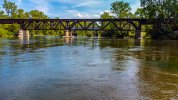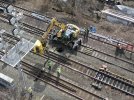Been flying the Mini 2 for about 3 weeks now. Today's outing got me looking for some clarification of a couple things. First one is the 400' from structures. From the attached photo I believe I am supposed to stay 400' away from the railroad trestle and the road bridge beyond it, no flying down the tracks between the rails or under the trestle trying to get awesome shots. Would that all be correct?
Second item is the 400' agl for this type of location. As you can see the train tracks, and the road bridge just beyond, are about 50' above where I am standing. I was wondering, does the 400' AGL apply to my level or would it be from the level of the tracks and roadway?

Second item is the 400' agl for this type of location. As you can see the train tracks, and the road bridge just beyond, are about 50' above where I am standing. I was wondering, does the 400' AGL apply to my level or would it be from the level of the tracks and roadway?














